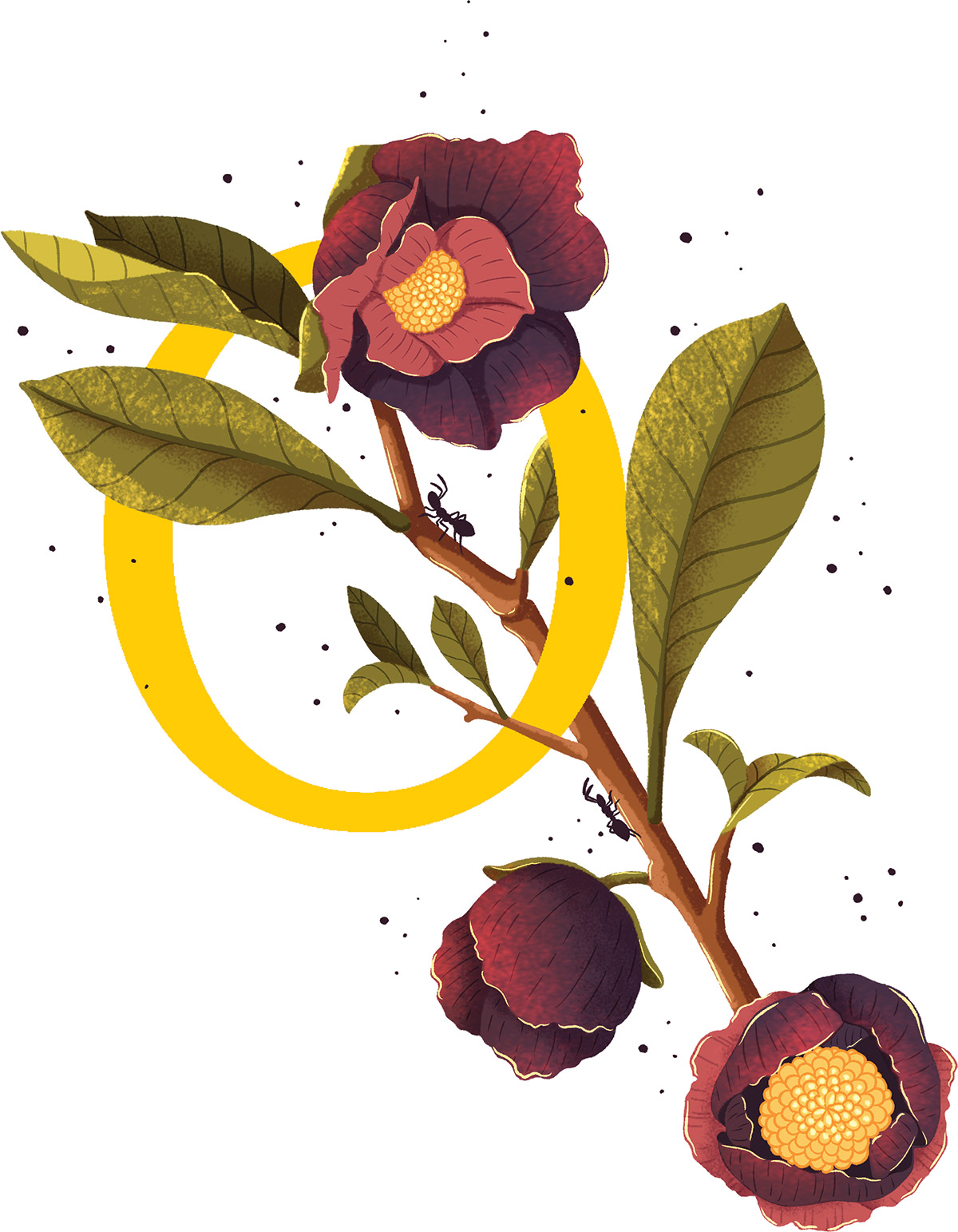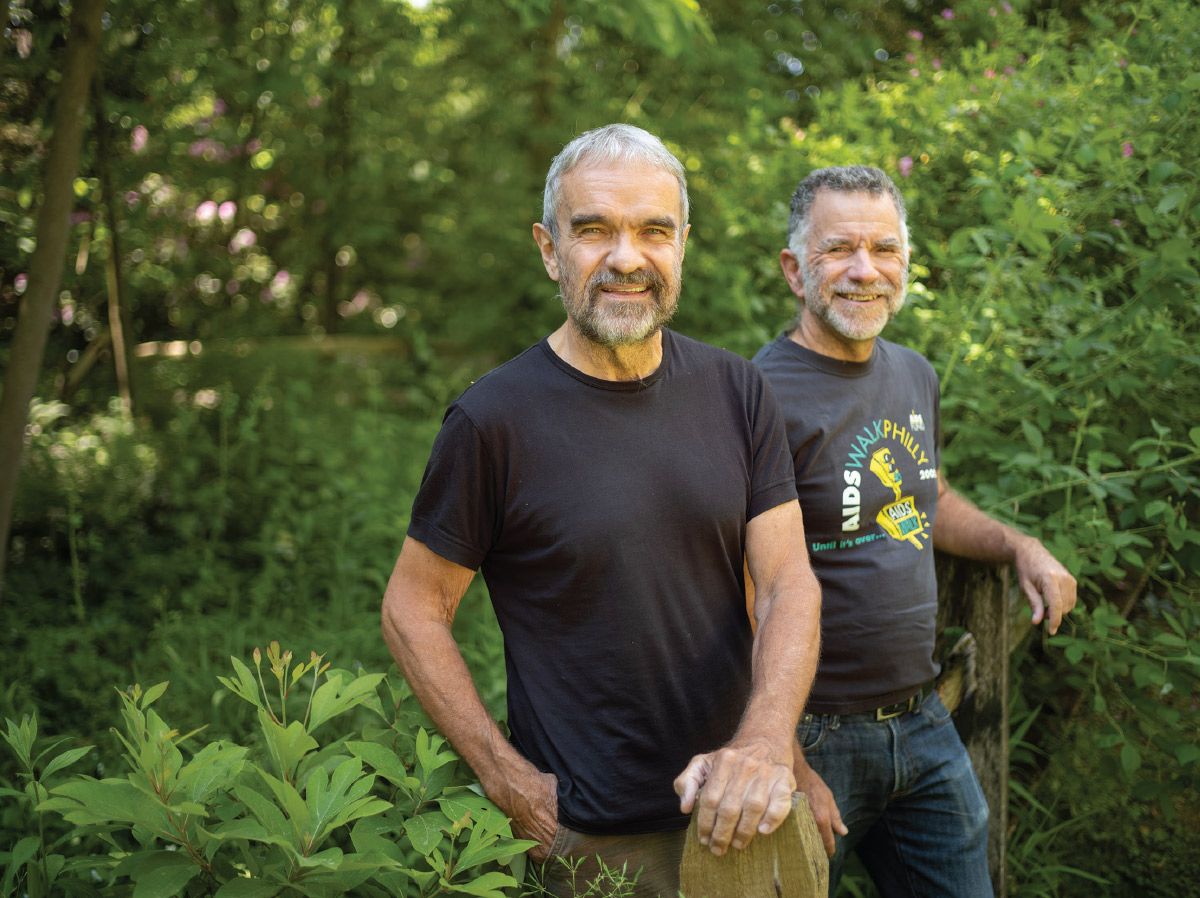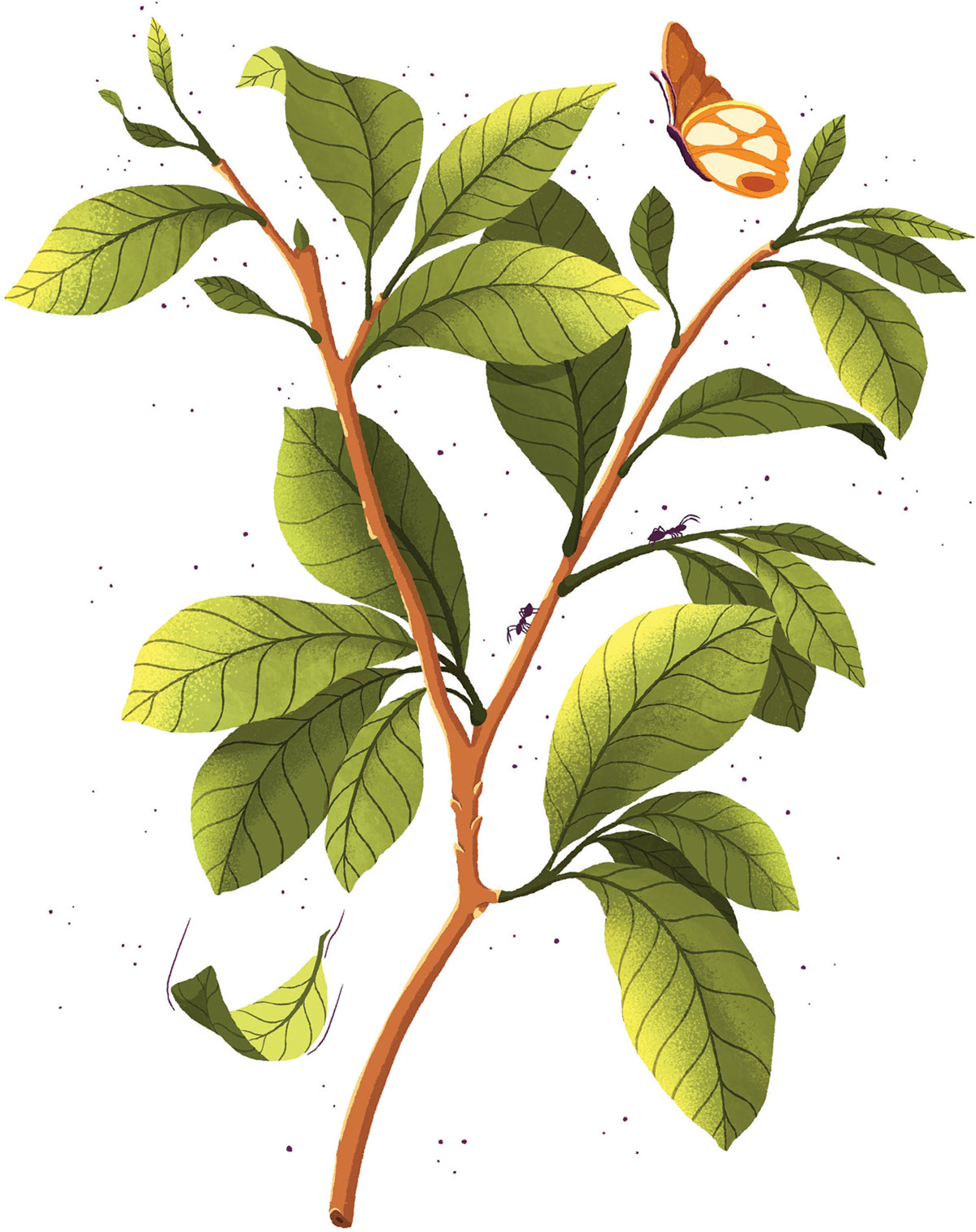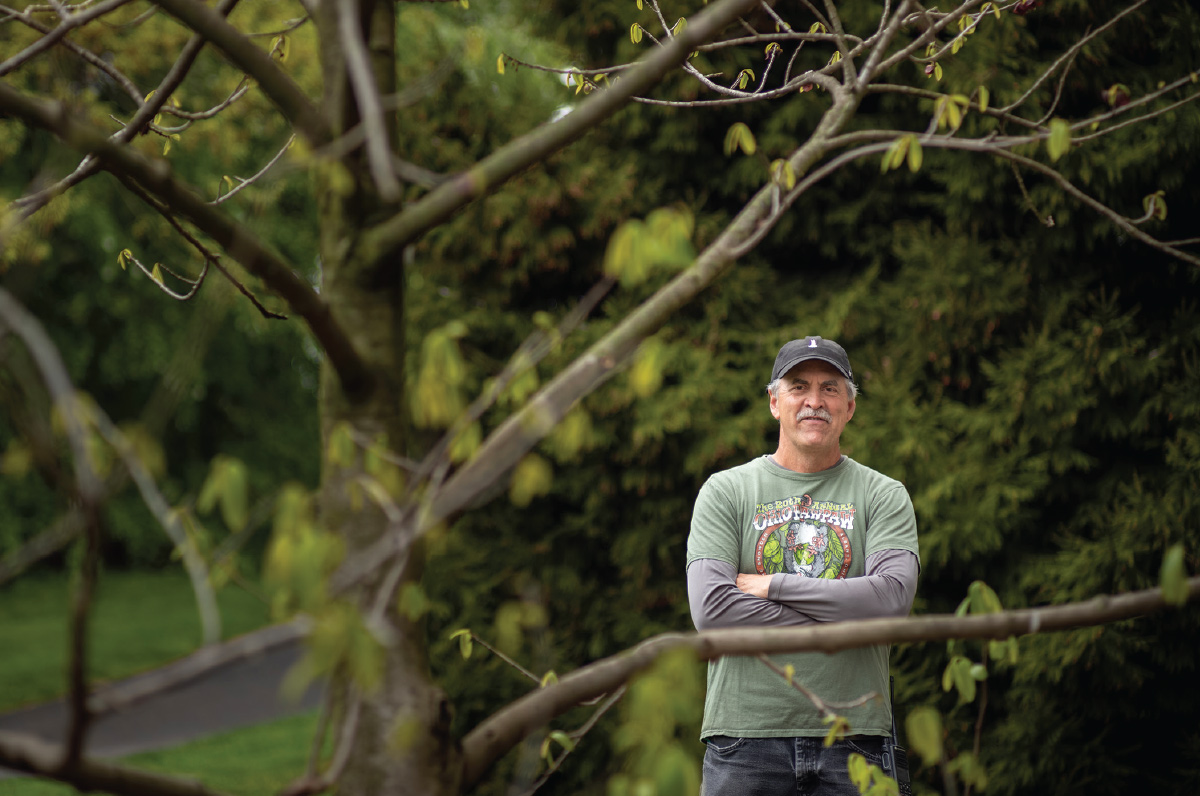The Fruit is Out There
illustrations by Luiza Laffitte
illustrations by Luiza Laffitte

Walking into Latham’s yard, one feels like they’ve wandered much further into the woods than they intended, and perhaps further back into time, too — before this land was cleared and subdivided into private lots, before the Lenape were driven away by European and American colonizers, and even before humans themselves became part of the ecosystem.
Venturing deeper into a winding path, lush with leafy understory growth and shaded by towering sugar maples, Latham points out what draws many people to his garden: his pawpaw trees.
The pawpaw (Asimina triloba) is shrub-like and unassuming with a modest stature, thin trunk, and spindly branches. Its leaves, which, by the summertime, will grow nearly 12 inches long into ruffled, oversized teardrops, are just starting to appear. Compact greenish-burgundy flowers dot the otherwise bare branches, marking spots where the pawpaw fruit — the largest edible fruit native to North America — will appear in the early fall.
“Some say they taste like banana, mango, and pineapple,” Latham says. “It’s a mild, slightly sweet kind of custard flavor.” Tropical yet autumnal, often with hints of vanilla — an unexpected flavor to be emerging each year from the mid-Atlantic fall.
Latham is an ecologist, evolutionary biologist, researcher, gardener, and former professor of biology at Swarthmore who lives in nearby Rose Valley, Pa. Clad in sturdy, well-worn workwear bearing evidence of the labor required to maintain a small forest, Latham begins to describe the world as it was nearly 40 million years ago during the Eocene period — the world from which pawpaws emerged.
“This was after the asteroid, after the dinosaurs, when life had rebounded. The earth had reached the peak of warmth,” Latham says. “Mammals had gotten bigger and more diverse than they ever had been before, and the earth was hot — there was no ice at the poles, and the ocean was significantly deeper than it is today.
“But then things began to cool during the Pleistocene. About two million years ago, the polar ice caps grew very big, resulting in a series of ice ages. And pawpaws, they lived through all of that,” Latham says.

Next door, a lawn mower revs, invisible through Latham’s thick stand of trees. With a puff of exhaust, the whirring blades shudder to life and interrupt the calm with a steady growl.
“Pawpaws were around when mammoths, mastodons, giant ground sloths, and the giant short-faced bear lived right here, in Delaware County,” Latham continues, speaking over the noise. “The pawpaws saw all of them come and go, and here they are still — now watching, sadly, as our earth is degrading.”
Given their survival through long periods of intense heat and cold, pawpaw trees are well-suited for climate change. Because they can tolerate extreme temperatures and shade, and naturally resist disease, deer, insects, and other pests, pawpaws are uniquely poised to survive as the earth’s climate warms. The flowers, which have a long blooming period, are pollinated by flies, rather than more vulnerable bees.
These resilient characteristics, along with the fruit’s uniquely tropical appearance and taste, evolved over millions of years as the pawpaw gradually moved northward. This move made the pawpaw both frost- and heat- tolerant, key to its evolutionary survival. While the pawpaw now grows only in North America, particularly in southern Ohio and Pennsylvania, its closest evolutionary relatives include the tropical custard apples of Central and South America.
How did the pawpaw journey north, millions of years before humans arrived? According to Latham, it was likely moved by a large migratory animal that ate the fruit and deposited the seeds. But as for which ancient animals – that remains a mystery. “Nobody knows,” says Latham, “because whatever it was, it’s clearly extinct.”
In fact, it’s widely believed that the arrival of humans in North America during the Pleistocene period secured the pawpaw’s success and saved it from potential decline.
“There’s a pretty plausible theory that most pawpaw stands that exist now were planted by Native Americans,” Latham says. “Humans took over the task of distributing the fruits and seeds of pawpaw, because it’s a great food source for people.”

In part, this is because of the aforementioned unusual pawpaw pollinator — the fly.
As unpollinated pawpaw flowers grow, they change from female to male, take on a darker burgundy hue that some say resemble meat, and produce a smell of fermenting fruit that attracts fruit flies and other pollinating insects.
When left to pollinate naturally without human intervention, the fruit’s flavor can be inconsistent; flies aren’t as efficient or reliable pollinators as bees are — they’re forgetful and easily distracted.
And because not all wild pawpaws have a palatable flavor, it’s commonly believed that a so-called “wild” patch of especially good-tasting pawpaws is likely evidence of human stewardship, cultivation, and settlement.
campus as a sacred space
“We would eat the fruits since they grew wild and they had this indescribable creamy banana taste,” says Chireau.

Chireau, whose courses include Folk and Popular Religions, Black Women’s Spirituality, From Vodun to Voodoo, and Religion in America, teaches the first-year seminar Religion and Food. As Chireau explains, the seminar delves into “how the foodways and folkways that people create are associated with religious ideas, and especially those traditions that can make food practices sacred.”
“As an arboretum, our entire campus can be conceived of as a sacred space,” Chireau says. “For those Indigenous inhabitants who lived on the land that Swarthmore College occupies, foraging was once a way of life in a world where most things had spiritual significance. So for all of us, food is more than just food. In our class, we read about Native American, African American, Anglo American, and other cultures that engage with the concepts and meanings of food in different ways that relate to religious meaning.”
The pawpaw is one way Chireau helps her students access the histories, stories, and human experiences around religion in America. In collaboration with Lars Rasmussen, horticultural staff member at the Scott Arboretum, Chireau invites students to taste pawpaw fruit during the course. Each fall, Rasmussen makes homemade pawpaw ice cream for the occasion.
Despite the fruit’s prevalence in this region, most students experience the fruit’s unique flavor and texture for the first time during the class.
“It just blows their minds,” says Rasmussen, who also takes students on tours of the campus’s pawpaw trees, many of which grow along the sloped banks of the Crum Creek.
During the last few years, Arboretum staff planted additional trees there to help stabilize and restore the hillside. One especially notable pawpaw tree is located directly outside of Willets residence hall, where, according to Rasmussen, it’s been growing since 1980.
“To taste it is an amazing experience for students — this large, tropical- tasting thing from North America. How do we not know about this?” says Rasmussen. “They find this total connection to where they’re living and where they are.”
So why aren’t pawpaw fruits more popular in supermarkets?
“For one, they’re very perishable,” says Rasmussen. “You can’t pick the fruit early, because it doesn’t ripen well. It bruises easily and doesn’t have a long shelf life.” Big seeds, nearly the size of a quarter, and a sometimes slimy texture have also contributed to the pawpaw fruit’s niche appeal — not to mention the difficulty in ensuring a consistent flavor.
The pawpaw tree has rich and often complicated cultural associations and histories.
Though the plant has been cultivated, harvested, consumed, and used by Indigenous people across North America for thousands of years — including the Algonquian, Catawba, Cherokee, Chickasaw, Choctaw, Creek, Iroquois, Lenape, Osage, Sioux, and Yuchi — anecdotes from American history often simply describe pawpaws as one of George Washington’s favorite fruits, or a source of sustenance for the Lewis and Clark expedition.
Chireau counters: Pawpaws “are deeply embedded in Native American memory and they embody the unique relationship that these people have to the land. From my own research, I also know that enslaved Black people grew these outside of their own dwellings.”
Throughout the 19th century and into the 20th century, the pawpaw was often dismissed as a less-desirable fruit for the poor and the rural working class.
As the New York Times wrote in November 1922, “The pawpaw is the most neglected of American fruits; few people like it, and someway it is as despised as the mule and as unpopular as the shitepoke.”
Pawpaw Ice Cream
“Vanilla, walnuts, and other flavors and ingredients work well with pawpaw. But if this is your first batch, I would encourage you to try it plain and to let the pawpaw stand on its own. The following is my basic pawpaw ice cream recipe:
2 cups pawpaw pulp (or more, if you have it)
1 cup sugar
2 cups cream
2 cups milk
Combine the pawpaw and sugar. Stir in the cream and milk. Pour the mixture into an ice cream maker and freeze according to the manufacturer’s directions.”
If you don’t have an ice cream machine, follow this method: Whip two cups of heavy cream until stiff peaks form. Slowly whip in 14 oz of sweetened condensed milk, then stir in your pawpaw pulp (up to two cups). Transfer to an airtight container and freeze.
Note: Fresh pawpaw pulp freezes well and can be stored in the freezer for up to six months.

Rasmussen attends the annual Ohio Pawpaw Festival — one of the largest, he says. “During COVID, I think there was a lot more interest just because people were out in their backyards and outdoors more, and I’m starting to see some in the markets every once in a while.”
As the world continues to recalibrate in the shadow of COVID-19 and as issues like food access and climate change become increasingly critical, it’s possible that interest in the pawpaw — specifically its climate resilience — may continue to grow.
joyful and generous
Latham’s annual pawpaw gathering is also a celebration of southeastern Pennsylvania’s local ecology. For Latham, being aware of and connected to his ecology is a deep source of fulfillment.
“It brings me more joy than almost anything else in my life,” he says. “I’m at my happiest when I’m hiking in a beautiful wilderness area, and I’m at my second-happiest when I’m working in my yard. I have always had a really strong attachment to the local flora, fauna, and funga. And I made it my life’s work.”
Inspired by her collaboration with Rasmussen, Chireau also grows pawpaw trees at her home — planted as seedlings, and they’ve since grown into 9-foot-tall trees.
“I wanted to grow pawpaws for a long time, and Lars was the one who encouraged me to take the plunge. Because it really is one of those plants that can become a friend, since they have distinct personalities and unique stories to tell,” Chireau says. “I haven’t eaten any fruit from my tree thanks to the raccoons, skunks, and other hungry creatures that get them before me, but I am happy to let the animals eat what they want.”

He carefully uses a soft paintbrush to deposit pollen into the flower. This is meticulous work — the kind of task that forces one to slow down and think about their own connection to ecology.
Before returning to work, Rasmussen reaches into his bag to retrieve a well-loved book he’s brought with him: Beyond the Pawpaw Trees — a children’s book he used to read to his daughter.
Fancifully illustrated and written in 1956 by Palmer Brown ’41, a Chicago-born writer and artist who attended Swarthmore, the book tells the tale of Anna Lavinia, a girl who ventures “beyond the walled garden where the pawpaw trees grow.”
In this story, the pawpaws mark a boundary between the world she knows and another, more magical world that exists right alongside it.
“Pawpaws are there, and then they’re gone,” says Rasmussen. “They’re one of those things that require you to take your time and carefully observe the world around you — the fruit is out there for just a few days.”